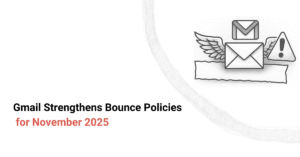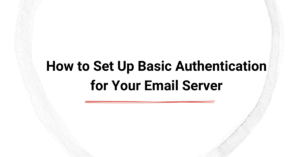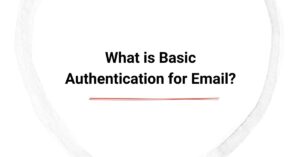Knowing how to fix and improve IP reputation is essential for businesses relying on email marketing campaigns to reach their target audiences. Without a decent reputation score, even the most well-crafted marketing emails can end up in recipients' spam folders.
This is because internet service providers (ISPs) validate the trustworthiness of the sender's IP address before directing emails to the recipient's inbox. Therefore, as an entrepreneur or business owner, improving your IP reputation is paramount.
A damaged IP reputation can feel overwhelming. However, with the right approach, it is possible to repair and improve it. In this blog, we discuss the key factors affecting IP reputation and the steps you should take to rebuild trust with ISPs. Boost email deliverability with our IP reputation analysis and ensure your next email campaign meets customers in their inboxes.
Summarizing the Main Points:
- Use IP reputation services like Google Postmaster Tools, Sender Score, and Barracuda Reputation System to uncover problems like spam complaints, blacklisting, or high bounce rates.
- Address blacklisting, clean your email lists, and authenticate your emails to improve your IP reputation.
- Gradually warm up your IP with consistent, compliant email practices to build trust with ISPs.
- Track your reputation regularly, authenticate your emails, and send relevant content to prevent spam complaints and maintain your IP reputation.
What is IP Reputation and Why Does It Matter?
IP reputation is a measure of the trustworthiness of an IP address. ISPs assign this reputation to each IP address based on several factors, including email volume, sending frequency, and engagement rates.
If your IP address consistently sends high-value emails that recipients engage with, it signals the ISP that your IP is trustworthy. This trust translates into higher email deliverability rates, allowing your emails to land in recipients' inboxes instead of their spam folders.
On the contrary, if your IP address frequently sends emails that bounce or recipients mark as spam, it hampers your credibility with ISPs. A poor reputation can result in email throttling, where ISPs and email service providers (ESPs) limit the number of emails delivered, or even blacklisting, which prevents your emails from being delivered at all. If left unchecked, a bad IP reputation score can permanently damage your email sender reputation and brand image.
Furthermore, the importance of a good IP reputation extends beyond the technical considerations. It also impacts the effectiveness of your email marketing campaigns, your brand’s credibility, and your ability to communicate with your audience.
For example, if your emails fail to reach recipients, you not only waste resources but also lose the opportunity to nurture leads or engage customers. Therefore, improving your IP reputation is essential for achieving your business goals.

Signs of a Poor IP Reputation
Low IP reputation doesn’t happen overnight. Understanding the symptoms can help you diagnose problems before they escalate further. Here are three early signs of a bad reputation score.
Bounce Rates
One of the most common indicators of a poor IP reputation is a high bounce rate. If a significant percentage of your emails are returned as undeliverable, it may indicate that your email list contains invalid addresses or inactive subscribers. Over time, a bounce rate signals to ISPs that your list hygiene is inadequate, which damages your reputation.
Spam Complaints
Spam complaints are another warning sign. When recipients mark your emails as spam, ISPs view it as a red flag. High spam complaint rates suggest that you are sending spam content. Even if only a small fraction of recipients flag your emails, it can raise spam reports, leading to major consequences for your IP reputation over time.
Blacklisting
Email blacklists, such as those managed by Spamhaus or Barracuda, are databases of IP addresses that are flagged for sending spam or suspicious activity. If your IP address is blacklisted, it means ISPs are actively blocking your emails. Use tools like MxToolbox and Spamhaus Reputation Checker to check if your IP address data is on any major blacklist.
Low Sender Score
Low sender scores are also a key indicator of a poor sender reputation. Sender Score rates your IP address on a scale from 0 to 100. A score below 80 typically signals that your reputation needs attention. Mailbox providers verify your email sender reputation score before delivering mails to recipients' inboxes.
Steps to Improve IP Reputation
Now that you are aware of the importance of maintaining a stellar IP reputation, let's walk you through the steps to improve it.
Step 1: Diagnose the Problem
To fix your IP reputation, you first need to pinpoint the root cause of the issue. There are several tools available to help assess your IP health. Google Postmaster Tools is a valuable resource for monitoring spam complaints, bounce rates, and other deliverability metrics. Sender Score, Talos Intelligence, and Barracuda Central also provide similar services.
Step 2: Addressing Blacklisting Issues
IP blacklisting can halt your email operations entirely, so immediate action is necessary. Start by identifying which blacklist has flagged your IP. Once identified, contact the blacklist provider directly. Most blacklists, such as Spamhaus or Barracuda, have dedicated delisting processes that outline the steps required to address the issue. You may need to provide evidence that the issue has been resolved.
Step 3: Improve List Hygiene
Email list hygiene is one of the most important factors in maintaining a healthy IP reputation. Cleaning your email list regularly is critical to resolving these issues. Start by removing invalid email addresses. Email verification tools like Alfred by Email Industries can help identify and eliminate invalid addresses. Additionally, segment your list to focus on engaged users.
Subscribers who regularly open and interact with your emails are less likely to mark them as spam. Implement a double opt-in for new subscribers to prevent invalid addresses from being added to your contact list.
Step 4: Authenticate Your Emails
Proper email authentication is critical for improving your IP reputation. Authentication records, such as SPF (Sender Policy Framework), DKIM (DomainKeys Identified Mail), and DMARC (Domain-based Message Authentication, Reporting, and Conformance), play a key role in establishing and maintaining a positive domain reputation. Configuring these authentication methods correctly can be complex. Hence, it’s advisable to work with your hosting provider or IT team to ensure everything is set up properly.
Step 5: Monitor and Reduce Spam Complaints
Spam complaints are a major contributor to poor IP reputation. Hence, it's paramount to address this issue. Personalized emails that address the recipient’s preferences and interests are less likely to trigger spam reports. Additionally, provide a clear unsubscribe option at the top of the email to simplify unsubscribing. This can drastically reduce the spam complaint rate.
Step 6: Warm Up Your IP Address
Rebuilding your reputation requires patience and consistent effort. You should gradually increase your sending volume while monitoring key metrics, such as open rates and complaints. This process, known as IP warm-up, helps re-establish credibility with ISPs. For best results, maintain a predictable sending schedule and focus on delivering high-quality, relevant content.
Step 7: Maintain Consistent Sending Practices
Consistency is key to sustaining a healthy IP reputation. Avoid sudden spikes in email volume, stick to a predictable sending schedule, and deliver personalized emails to stand out in the inbox and encourage recipients to engage with your email messages. This builds reliability and trust with ISPs over time.
Best Practices for Sustaining a Healthy IP Reputation
Fixing your IP reputation is only the first step. To ensure long-term success, you must maintain it to boost email deliverability. Here are three proven email sending practices for maintaining a stellar IP reputation score.
Regularly Monitor Your IP Reputation
Regularly monitoring your IP health is essential. Use tools like Spamhaus, MxToolbox, and Talos Intelligence to keep track of your IP health. Also set up alerts for changes in key metrics, such as bounce rates or spam complaints, so you can address issues promptly.
Follow Email Compliance Laws
Compliance with email regulations, such as CAN-SPAM, GDPR, and CASL, is also crucial. These laws require clear opt-in and opt-out mechanisms, accurate sender information, and transparent content. Following these rules not only avoids legal issues but also demonstrates to ISPs that you’re a responsible sender.
Engage Your Audience
Engaging your audience with valuable, relevant content is another important factor. By segmenting your lists and tailoring your messages, you increase the likelihood of positive engagement, which reinforces your reputation over time.
Start to Improve Your IP Reputation Today
Improving your IP reputation is a multi-step process that requires identifying and addressing the root causes of poor reputation, such as high bounce rates or spam complaints. By cleaning your email lists, authenticating your emails, and gradually warming up your IP, you can rebuild trust with ISPs and improve your email deliverability.
Maintaining a strong IP reputation involves continuous monitoring, compliance with email regulations, and a focus on delivering engaging content. With a systematic approach, you can not only fix your IP reputation but also ensure long-term success in your email marketing efforts. Struggling with IP reputation issues? Book a discovery call today for a free IP reputation audit and get your deliverability back on track today!









